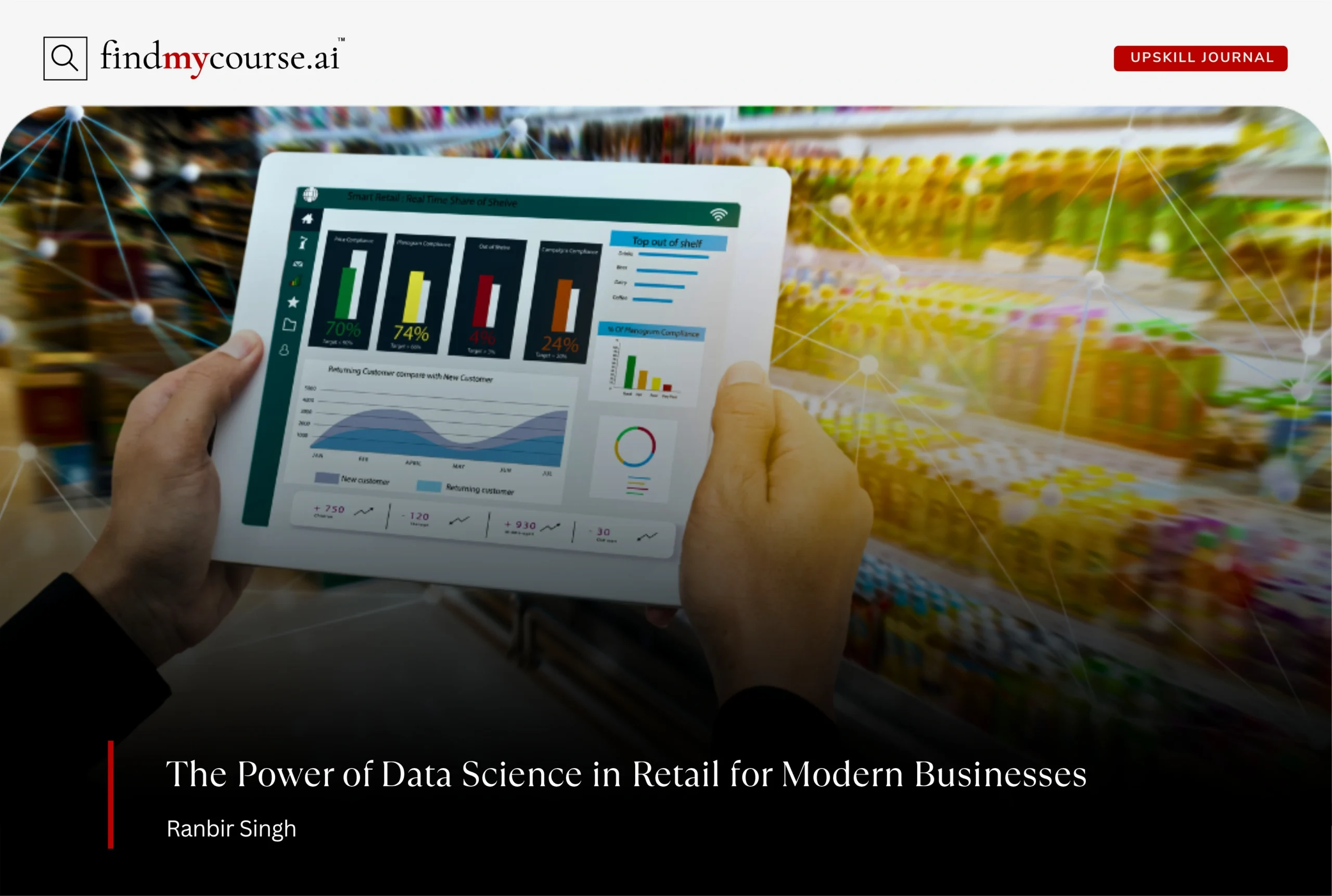Imagine walking into a store where every shelf seems to know exactly what you want, or browsing online and seeing recommendations that feel almost psychic. That’s the power of data science in retail at work—turning countless customer interactions into insights that drive smarter decisions, personalized experiences, and seamless operations. From predicting trends to optimizing supply chains, data science has become the invisible force shaping how businesses connect with customers, operate efficiently, and stay ahead in an ever-changing market. For professionals and aspiring leaders, learning how to leverage these insights is key to thriving in today’s data-driven retail landscape.
The Expanding Role of Data Science in Retail
Retail today runs on data. From global e-commerce giants to local stores, decision-making is increasingly powered by analytics, artificial intelligence, and automation. Additionally, retailers no longer rely solely on intuition—they depend on insights drawn from millions of data points collected across every channel.
Moreover, data science in retail serves as the intelligence layer that connects strategy to action. It gathers, analyzes, and translates raw information into patterns and predictions that guide key business areas:
- Customer experience: Understanding preferences, habits, and intent to create relevant interactions.
- Operations and logistics: Forecasting demand, optimizing inventory, and ensuring the right products are in the right place at the right time.
- Pricing and promotions: Adjusting offers dynamically based on trends, seasonality, and competitor behavior.
- Fraud detection and risk management: Identifying irregular transactions and protecting both business and consumers.
Moreover, the integration of machine learning and real-time analytics allows retailers to react instantly, not months later. As a result, businesses can stay agile in an unpredictable market—one where consumer expectations evolve by the day.
Key Applications of Data Science in Retail
Data science is reshaping every facet of retail, from customer interactions to operational efficiency. Here are some of its key applications that shows how analytics, AI, and predictive models drive smarter decisions, enhance experiences, and create measurable business value.
1. Personalizing Every Customer Experience
Data science allows retailers to anticipate customer needs through predictive models and behavior analysis. Personalized recommendations, tailored marketing, and adaptive in-store experiences strengthen loyalty and satisfaction. Tools like recommendation systems, segmentation models, and sentiment analysis help brands understand and engage customers, creating seamless interactions that feel intuitive and human, turning transactions into meaningful, personalized experiences that encourage repeat visits and long-term engagement.
2. Streamlining Operations and Supply Chains
Data science revolutionizes supply chain efficiency. By analyzing sales trends, weather, and local events, retailers can forecast demand accurately, reduce stockouts or overstock, and optimize distribution routes. Predictive analytics also supports sustainable operations by minimizing carbon emissions. These insights ensure products are available when and where customers need them, while saving time, cost, and operational resources, creating smarter and more resilient retail logistics.
3. Optimizing Pricing and Promotions
Retail pricing is now a science. Using data on competitor pricing, demand trends, and customer behavior, dynamic pricing models maximize profit without alienating shoppers. Promotions are refined through A/B testing and performance analytics to identify the most effective messaging. Data-driven pricing allows retailers to adjust offers in real time, improving competitiveness and responsiveness while ensuring pricing decisions are precise, fair, and aligned with market realities.
4. Enhancing Fraud Detection and Risk Management
As digital transactions grow, data science protects both retailers and consumers. Machine learning models detect anomalies and flag suspicious behavior in real time, preventing fraud. Predictive analytics also helps identify patterns that may indicate financial risk or operational inefficiencies, allowing proactive interventions. This ensures a secure, trustworthy shopping environment while reducing losses and strengthening the integrity of retail operations.
5. Predicting Trends and Consumer Behavior
Data science enables retailers to anticipate future buying behavior by analyzing social media, search data, and historical purchases. Brands can spot emerging trends early, plan campaigns, and optimize inventory to meet demand. AI-driven trend forecasting reduces overproduction, avoids stockouts, and positions retailers as trend leaders rather than followers, creating both financial efficiency and a competitive edge in fast-moving markets.
6. Driving Sustainability and Ethical Retailing
Retailers can use data science to make sustainability measurable and actionable. Tracking energy use, supply chain emissions, and product lifecycles helps reduce waste, balance supply and demand, and minimize carbon impact. Real-time dashboards and predictive models allow businesses to monitor environmental performance continuously. By integrating sustainability into operations, retailers not only protect the planet but also enhance brand trust and operational efficiency.
7. Reinventing In-Store and Omnichannel Experiences
Data science is transforming physical stores and online channels alike. Smart sensors, heat maps, and AI cameras reveal customer movement patterns to optimize layouts and staffing. Omnichannel analytics ensure seamless experiences between in-store, apps, and websites. Personalized digital displays and recommendations create immersive, data-driven shopping journeys that make the customer experience consistent, engaging, and highly responsive across all channels.
Data Science in Retail at Work: Real-World Transformations
Data science is driving real change across both online and in-store retail. By turning data into actionable insights, retailers are personalizing experiences, optimizing operations, and boosting growth. From predicting customer preferences to keeping shelves stocked efficiently, data-driven strategies are transforming every aspect of retail. Here are some real-world examples showing this impact of data science in retail:
- Amazon: Uses advanced recommendation engines to analyze browsing and purchase behavior, contributing to nearly 35% of total revenue.
- Walmart: Machine learning forecasts inventory and demand across physical stores and e-commerce, reducing overstock by 20% while keeping high-demand products available.
- Sephora: AI-driven personalization tailors both in-store and digital marketing campaigns, boosting customer engagement and loyalty.
- Zara: Leverages real-time sales and foot traffic data from stores to optimize inventory and adjust collections quickly.
- Target: Predictive analytics anticipate customer needs to design promotions and stock popular items efficiently.
These examples show how data science is not just improving online platforms but also transforming traditional retail stores, creating smarter, more responsive, and highly personalized shopping experiences.
Key Challenges in Data-Driven Retail
Implementing data science in retail brings tremendous opportunities, but it also comes with significant challenges. Understanding these hurdles helps businesses prepare and plan more effectively for a successful data-driven transformation.
Key Challenges:
- Legacy Infrastructure: Many retailers rely on outdated systems that struggle to support modern analytics, requiring upgrades or complex integrations.
- Integration Complexity: Merging data from online, in-store, supply chain, and loyalty systems is technically challenging and can create inconsistencies.
- Real-Time Processing: Delivering instant insights demands robust computing resources, efficient pipelines, and advanced algorithms.
- Change Management: Teams may resist new workflows, necessitating training, communication, and leadership support for smooth adoption.
- Regulatory Compliance: Navigating global laws around data privacy, AI use, and consumer protection is complex but essential.
- Cost of Implementation: Deploying analytics solutions involves significant expenses for technology, talent, and ongoing maintenance.
- Measuring ROI: Without clear KPIs, tracking the impact of data initiatives and justifying investments is difficult.
Conclusion
The power of data science in retail isn’t just in the algorithms or dashboards—it’s in how you use insights to make smarter, more human decisions. Whether you’re a marketer, a store manager, or someone exploring a career in retail, understanding and applying these tools can transform the way you connect with customers, optimize operations, and drive growth. Embrace curiosity, experiment with data-driven strategies, and think creatively about the challenges and opportunities around you. By learning to work with data science in retail, you’re not just keeping up with the industry—you’re shaping its future, one insight at a time. And if you ever feel stuck along the way, remember you can always turn to our AI assistant for guidance in your journey.


